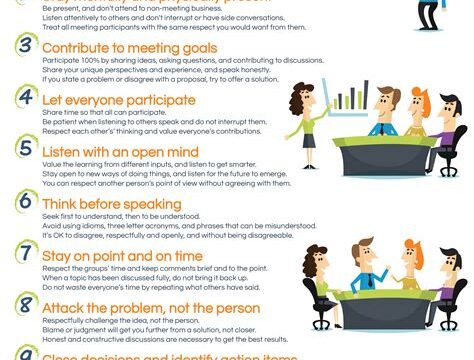Creating a Welcoming and Supportive Environment
Creating a welcoming and supportive environment is essential for fostering a positive learning experience. Whether you are a teacher, instructor, or facilitator, establishing a nurturing space can greatly contribute to the success and well-being of your students. When learners feel safe and supported, they are more likely to actively participate, take risks, and develop a growth mindset. Here are some effective strategies that can help you create such an environment:
1. Establish clear guidelines: Setting clear expectations and guidelines from the beginning can provide a sense of structure and predictability for the students. Clearly communicate your rules and policies regarding behavior, communication, and respect. This will help create a safe and inclusive space for everyone.
2. Foster positive relationships: Building positive relationships with your students is paramount. Take the time to get to know them individually, show genuine interest in their lives, and be approachable. Engage in active listening and offer support whenever needed. When students feel valued and connected, they are more likely to engage and thrive in the learning environment.
3. Encourage collaboration and teamwork: Promote a sense of community and teamwork by incorporating collaborative activities and projects in your teaching. Working together not only fosters critical thinking and problem-solving skills but also strengthens interpersonal relationships among the students. Encourage the exchange of ideas, active participation, and peer support.
4. Celebrate diversity and inclusion: Embrace and celebrate the diversity within your classroom. Create an environment where every student feels respected and included, regardless of their background, culture, or abilities. Incorporate resources and materials that represent a variety of perspectives and experiences to provide a well-rounded learning experience for all.
5. Provide emotional support: Recognize that students may face challenges both inside and outside the classroom. Be sensitive to their emotional well-being and provide a safe space for them to express themselves. Show empathy, offer encouragement, and provide resources for additional support if needed. Remember that emotional support is a crucial aspect of creating a welcoming and supportive environment.
By implementing these strategies, you can cultivate a welcoming and supportive environment that promotes engagement, growth, and success for all students. As an educator, your role in creating such an environment is invaluable, and the impact it can have on your students’ lives is immeasurable.
Setting Clear Objectives and Expectations
Setting clear objectives and expectations is essential in any learning environment. It provides students with a clear direction, allowing them to focus and work towards specific goals. When objectives and expectations are clearly communicated, students are more likely to understand what is expected of them and what they need to achieve. This helps to create a sense of structure and accountability, which is crucial for effective learning.
Benefits of Setting Clear Objectives and Expectations:
- Increased Motivation: Clear objectives give students a purpose and motivate them to work towards achieving their goals. When students understand what is expected of them, they are more likely to feel motivated and engaged in their learning.
- Improved Focus: Clear objectives help students to stay focused on the task at hand. With a clear understanding of what needs to be achieved, students can allocate their time and effort more effectively.
- Enhanced Learning: When objectives and expectations are clearly communicated, students have a better understanding of what they need to learn and how they will be assessed. This helps them to engage with the material more deeply and achieve better learning outcomes.
How to Set Clear Objectives and Expectations:
| 1. Be Specific: | Clearly define what students need to achieve. Avoid vague or ambiguous language and provide specific guidelines for success. |
|---|---|
| 2. Make Them Achievable: | Ensure that the objectives and expectations are realistic and attainable for the students. Setting unrealistic goals can lead to frustration and demotivation. |
| 3. Communicate Clearly: | Clearly communicate the objectives and expectations to the students. Use different mediums such as verbal communication, written instructions, or visual aids to ensure understanding. |
| 4. Provide Examples: | Give students examples of what a successful outcome looks like. This helps students to visualize the expected result and understand the quality of work that is expected. |
| 5. Set Deadlines: | Assign deadlines for completing the objectives. This creates a sense of urgency and helps students manage their time effectively. |
| 6. Regularly Review and Reinforce: | Regularly review the objectives and expectations with the students to ensure they are on track. Reinforce the importance of achieving the goals and provide feedback as needed. |
Setting clear objectives and expectations not only benefits students but also helps teachers in guiding and assessing their progress. It creates a supportive learning environment where students can thrive and achieve their full potential. By setting clear objectives and expectations, educators lay the foundation for successful learning experiences.
Utilizing Interactive Writing Activities
Interactive writing activities can be a great way to engage students in the writing process and help them develop important skills. These activities not only make the learning experience more enjoyable but also enable students to actively participate in their own learning. By incorporating interactive writing activities into the classroom, educators can create an environment that fosters creativity, critical thinking, and collaboration.
One effective interactive writing activity is peer editing. This activity allows students to work together in pairs or small groups to review and revise each other’s writing. By providing feedback on their peers’ work, students can learn from one another and improve their own writing skills. This activity not only encourages collaboration but also helps students develop the ability to give and receive constructive feedback.
Another interactive writing activity is using online writing tools and platforms. These tools allow students to write and publish their work online, providing them with a wider audience and a greater sense of purpose for their writing. Additionally, these platforms often offer features such as spell check, grammar suggestions, and word count, which can help students improve the quality of their writing and develop important editing skills.
- Peer editing
- Using online writing tools and platforms
- Interactive writing prompts
| Benefits of Utilizing Interactive Writing Activities |
|---|
| Enhances creativity |
| Promotes critical thinking |
| Encourages collaboration |
| Develops important editing skills |
Incorporating interactive writing activities into the classroom can have numerous benefits for students. Firstly, it enhances their creativity by allowing them to think outside the box and explore different writing styles and genres. This can help them develop their unique voice and express their ideas more effectively.
Furthermore, interactive writing activities promote critical thinking as students are prompted to analyze and evaluate their own and others’ writing. They learn to identify strengths and weaknesses in their work and make informed decisions on how to improve it. This not only improves their writing skills but also enhances their analytical and problem-solving abilities.
Utilizing interactive writing activities also encourages collaboration among students. By working together on peer editing tasks or group writing projects, students learn to communicate effectively, cooperate with others, and appreciate diverse perspectives. This fosters a supportive and inclusive classroom environment where students feel valued and heard.
Lastly, interactive writing activities help students develop important editing skills. By actively engaging in the revision process, they learn to identify and correct spelling, grammar, and punctuation errors. This attention to detail not only improves the overall quality of their writing but also prepares them for future writing assignments and professional endeavors.
Encouraging Collaboration and Peer Feedback
Collaboration and peer feedback are essential components of a successful learning environment. By actively encouraging collaboration among students, educators can create an engaging and interactive classroom experience. Collaboration allows students to work together, exchange ideas, and learn from one another.
One effective way to encourage collaboration is through group projects and activities. Assigning tasks that require teamwork can promote communication and cooperation among students. For example, group presentations or problem-solving activities can foster collaboration and encourage students to share their knowledge and skills.
Peer feedback is another valuable tool for enhancing learning. Giving students the opportunity to provide feedback to their peers not only strengthens their understanding of the subject matter but also develops their critical thinking and communication skills. Peer feedback allows students to evaluate and analyze their classmates’ work, providing constructive criticism and suggestions for improvement.
Additionally, incorporating technology into collaborative activities can further enhance engagement and participation. Online platforms or collaborative tools can facilitate communication and knowledge sharing among students, even if they are not physically present in the same location. Utilizing technology can also provide opportunities for students to collaborate with peers from different backgrounds or cultures, broadening their perspectives and fostering a sense of global awareness.
In conclusion, encouraging collaboration and peer feedback in the classroom can have numerous benefits for both students and educators. By creating a supportive environment that promotes teamwork and active participation, students can develop essential skills and deepen their understanding of the subject matter. Through collaboration and peer feedback, students learn not only from their teachers but also from each other, fostering a dynamic and enriching learning experience.
Providing Prompt and Constructive Feedback
Providing prompt and constructive feedback is an essential aspect of effective teaching. By giving timely and constructive feedback to students, educators can help them identify their strengths and areas for improvement, thus enabling them to enhance their learning outcomes. This blog post will explore the importance of providing prompt and constructive feedback in the classroom and discuss strategies that teachers can employ to ensure its effectiveness.
One of the key benefits of providing prompt feedback is that it allows students to address their mistakes and misconceptions in a timely manner. When students receive feedback immediately after completing a task or assignment, they are more likely to remember the content and make necessary adjustments. Furthermore, prompt feedback helps to keep students engaged and motivated, as they can see the direct impact of their efforts.
In order for feedback to be effective, it must also be constructive. Constructive feedback focuses on areas for improvement rather than solely identifying mistakes. It provides specific suggestions and guidance for students to enhance their understanding and performance. For example, instead of simply pointing out that a student’s essay lacks organization, a teacher can provide specific techniques for structuring the essay effectively.
Implementing Effective Time Management Techniques
The importance of effective time management cannot be overstated. In today’s fast-paced world, being able to manage our time efficiently is crucial for productivity and success. Implementing effective time management techniques can help us achieve our goals, reduce stress, and maintain a healthy work-life balance. In this blog post, we will explore some practical strategies and techniques that can be employed to better manage our time and maximize our productivity.
One of the first steps towards effective time management is identifying our priorities. By clearly defining our goals and objectives, we can allocate our time and resources accordingly. This can be done by creating a to-do list or using a task management app to organize and prioritize our tasks. By focusing on the most important tasks first, we can ensure that we are making progress towards our goals.
Another effective technique for managing time is to break tasks down into smaller, more manageable chunks. This can help prevent overwhelm and procrastination, as well as increase productivity. By breaking down larger tasks into smaller, actionable steps, we can tackle them more easily and stay on track.
In addition to breaking tasks down, it is also important to allocate specific time slots for different activities. This can be done using a time blocking technique, where we schedule specific activities or tasks for specific time periods. By creating a structured schedule, we can minimize distractions and ensure that we are dedicating adequate time to each task.
Furthermore, it is important to be mindful of our energy levels throughout the day. We all have times when we are more alert and productive, as well as times when our energy levels dip. By identifying our peak productivity periods, we can schedule our most important or challenging tasks during those times. This can help us maximize our efficiency and make the most of our energy reserves.
In conclusion, implementing effective time management techniques is essential for achieving our goals and maintaining a healthy work-life balance. By identifying priorities, breaking tasks down, allocating specific time slots, and being mindful of our energy levels, we can make the most of our time and increase our productivity. Taking proactive steps towards managing our time can lead to greater success and fulfillment in all aspects of life. So let’s prioritize our tasks, establish a well-structured schedule, and make the most of our precious time!
- Identify priorities
- Break tasks down
- Allocate specific time slots
- Be mindful of energy levels
| Techniques | Benefits |
|---|---|
| Identifying priorities | Ensures focus on important tasks |
| Breaking tasks down | Prevents overwhelm and increases productivity |
| Allocating specific time slots | Keeps schedule organized and minimizes distractions |
| Being mindful of energy levels | Maximizes efficiency and productivity |
Incorporating Technology for Enhanced Engagement
Technology has become an integral part of our lives, impacting various aspects including education. In the modern classroom, it is essential for educators to leverage technology to enhance student engagement and learning outcomes. With the right tools and strategies, technology can make the learning experience more interactive, collaborative, and memorable for students. In this blog post, we will explore different ways in which teachers can incorporate technology to foster enhanced engagement among students.
Listed below are some effective ways to utilize technology for enhanced engagement:
- Interactive Presentations: Instead of traditional lectures, teachers can use interactive presentation tools such as PowerPoint or Prezi to create visually appealing and engaging lessons. These tools allow for multimedia integration, such as videos, images, and audio, making the content more interactive and stimulating for students.
- Online Collaborative Platforms: Platforms like Google Classroom or Microsoft Teams provide students with the opportunity to collaborate on projects, share documents, and provide feedback to their peers. These platforms not only encourage teamwork but also allow for easy access to resources, reducing the dependency on physical materials and fostering a digital and efficient learning environment.
- Virtual Field Trips: Technology enables educators to take their students on virtual field trips to different parts of the world without leaving the classroom. With the help of virtual reality (VR) headsets or online platforms like Google Expeditions, students can explore historical sites, natural wonders, or even outer space, enhancing their understanding and engagement in the subject matter.
Tablets, smartphones, and computers are no longer mere distractions in the classroom; they have the potential to revolutionize the way students learn and engage with the content. Incorporating technology into teaching practices is not about replacing traditional methods, but rather enhancing them and making learning more interactive, collaborative, and exciting for students.
Frequently Asked Questions
Q: How can I create a welcoming and supportive environment in my classroom?
A: You can create a welcoming and supportive environment in your classroom by fostering positive relationships with students, using inclusive language and gestures, showing empathy and understanding, and promoting open communication and respect among all members of the class.
Q: Why is it important to set clear objectives and expectations in the classroom?
A: Setting clear objectives and expectations helps students understand what is expected of them, provides a sense of structure and purpose in their learning, and allows for effective planning and assessment. It also helps create a focused and productive learning environment.
Q: What are some interactive writing activities that can be used in the classroom?
A: Some interactive writing activities include collaborative story writing, peer editing and revision, writing conversations or dialogue, interactive writing games or quizzes, and using technology tools such as online writing platforms or interactive whiteboards.
Q: How can I encourage collaboration and peer feedback in my classroom?
A: You can encourage collaboration and peer feedback by assigning group projects or activities, providing clear guidelines for effective collaboration, promoting active listening and constructive feedback skills, and creating opportunities for students to reflect on and discuss each other’s work.
Q: Why is prompt and constructive feedback important in the learning process?
A: Prompt and constructive feedback helps students understand their strengths and areas for improvement, guides their learning and growth, boosts their motivation and self-esteem, and ultimately enhances their overall performance and achievement.
Q: What are some effective time management techniques that can be implemented in the classroom?
A: Some effective time management techniques include prioritizing tasks, setting realistic deadlines, breaking larger tasks into smaller manageable chunks, creating a schedule or timetable, using timers or alarms, and teaching students strategies for effective time management.
Q: How can technology be incorporated to enhance engagement in the classroom?
A: Technology can be incorporated in various ways such as using interactive educational apps or websites, incorporating multimedia elements into lessons, facilitating collaboration through online platforms or tools, providing virtual field trips or simulations, and using online assessment or feedback tools.





